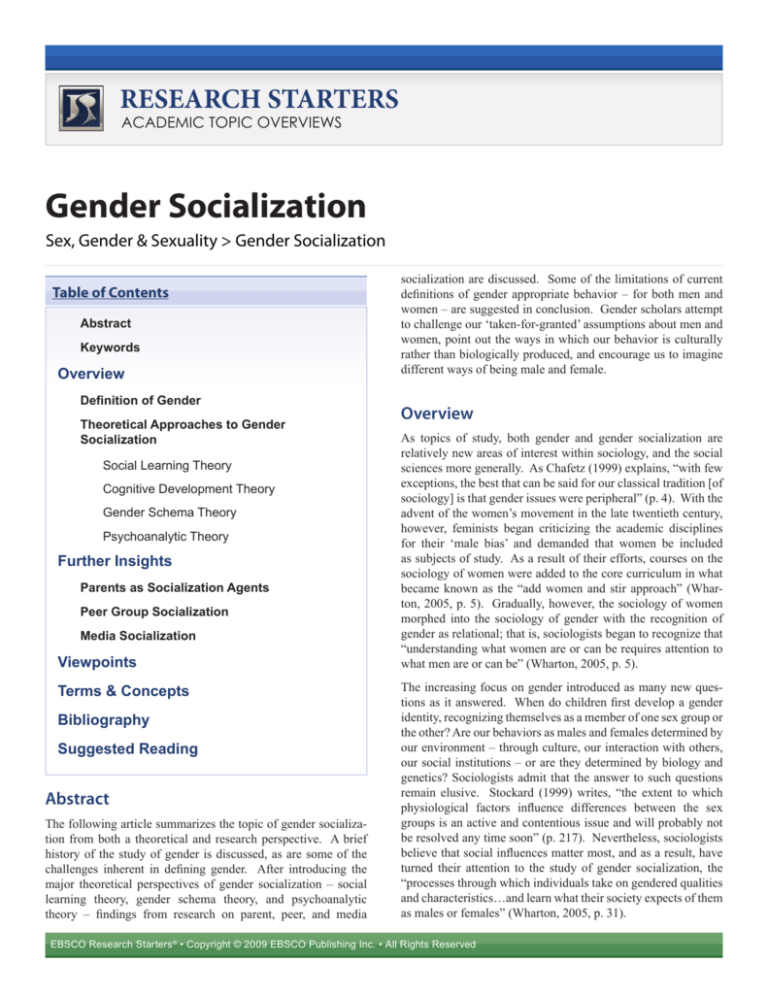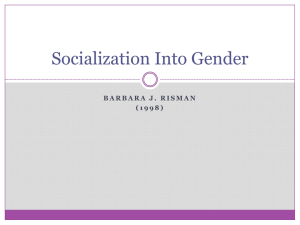
RESEARCH STARTERS
ACADEMIC TOPIC OVERVIEWS
Gender Socialization
Sex, Gender & Sexuality > Gender Socialization
Table of Contents
Abstract
Keywords
Overview
Definition of Gender
Theoretical Approaches to Gender
Socialization
Social Learning Theory
Cognitive Development Theory
Gender Schema Theory
Psychoanalytic Theory
Further Insights
Parents as Socialization Agents
Peer Group Socialization
Media Socialization
Viewpoints
Terms & Concepts
Bibliography
Suggested Reading
Abstract
The following article summarizes the topic of gender socialization from both a theoretical and research perspective. A brief
history of the study of gender is discussed, as are some of the
challenges inherent in defining gender. After introducing the
major theoretical perspectives of gender socialization – social
learning theory, gender schema theory, and psychoanalytic
theory – findings from research on parent, peer, and media
socialization are discussed. Some of the limitations of current
definitions of gender appropriate behavior – for both men and
women – are suggested in conclusion. Gender scholars attempt
to challenge our ‘taken-for-granted’ assumptions about men and
women, point out the ways in which our behavior is culturally
rather than biologically produced, and encourage us to imagine
different ways of being male and female.
Overview
As topics of study, both gender and gender socialization are
relatively new areas of interest within sociology, and the social
sciences more generally. As Chafetz (1999) explains, “with few
exceptions, the best that can be said for our classical tradition [of
sociology] is that gender issues were peripheral” (p. 4). With the
advent of the women’s movement in the late twentieth century,
however, feminists began criticizing the academic disciplines
for their ‘male bias’ and demanded that women be included
as subjects of study. As a result of their efforts, courses on the
sociology of women were added to the core curriculum in what
became known as the “add women and stir approach” (Wharton, 2005, p. 5). Gradually, however, the sociology of women
morphed into the sociology of gender with the recognition of
gender as relational; that is, sociologists began to recognize that
“understanding what women are or can be requires attention to
what men are or can be” (Wharton, 2005, p. 5).
The increasing focus on gender introduced as many new questions as it answered. When do children first develop a gender
identity, recognizing themselves as a member of one sex group or
the other? Are our behaviors as males and females determined by
our environment – through culture, our interaction with others,
our social institutions – or are they determined by biology and
genetics? Sociologists admit that the answer to such questions
remain elusive. Stockard (1999) writes, “the extent to which
physiological factors influence differences between the sex
groups is an active and contentious issue and will probably not
be resolved any time soon” (p. 217). Nevertheless, sociologists
believe that social influences matter most, and as a result, have
turned their attention to the study of gender socialization, the
“processes through which individuals take on gendered qualities
and characteristics…and learn what their society expects of them
as males or females” (Wharton, 2005, p. 31).
EBSCO Research Starters® • Copyright © 2009 EBSCO Publishing Inc. • All Rights Reserved
Gender Socialization
Keywords
Essay by Jennifer Kretchmar, Ph.D.
• Gender as a process rather than a fixed state;
Cognitive Developmental Theory
• Gender as a characteristic of society as well as individuals; and
Gender
• Gender as a system that creates differences and inequalities (Wharton, 2005).
Gender Schemas
Sex
In addition, sociologists often study gender using different
frameworks. Some emphasize gender as a characteristic of the
individual, some as a product of social interactions, and others
as a characteristic of social institutions (Wharton, 2005). Wharton (2005) explains that all frameworks are “necessarily partial
and selective” and that none alone is sufficient for understanding gender. Those who are interested in socialization processes,
however, usually study gender as a characteristic of the individual; as such, much of the theoretical work on socialization
is drawn from psychology as well as sociology (Burn, 1996;
Wharton, 2005).
Social Learning Theory
Theoretical Approaches to Gender Socialization
Gender Segregation
Media
Parental Socialization
Peer Group Socialization
Psychoanalytic Theory
Definition of Gender
One of the first steps sociologists take in defining gender is
to distinguish it conceptually from the term sex. Burn (1996)
writes, “In most contexts, psychologists prefer the word ‘gender’
because it includes the idea that many differences between men
and women are culturally created while the word ‘sex’ implies
that the differences are caused directly by biological sex” (p.
xix). Thus, when referring to anatomical or reproductive differences between men and women, many social scientists use the
term sex; when referring to differences not directly caused by
biology – for example, different hair or clothing styles of men
and women – social scientists prefer the term gender.
Unfortunately, the distinction between sex and gender is not
quite so clear. Whereas defining key conceptual terms typically
clarifies, the varying definitions of sex and gender often muddy
the waters. As Wharton (2005) explains, “there is no firm consensus on the appropriate use of these two terms among gender
scholars. Some reject the term ‘sex’ altogether and refer only
to ‘gender.’ Others use the terms almost interchangeably…” (p.
18). The confusion stems largely from the varying degrees of
emphasis placed on biology and culture in understanding what
it means to be male and female. On one end of the spectrum are
those who believe gender is entirely socially constructed, and
therefore not grounded in any physiological reality (Wharton,
2005). On the other end are those who believe the two sexes are
a biological fact. And in the middle is the biosocial perspective,
the idea that gender is constructed within limits already established by our biology.
Although most agree that biology and society interact to shape
human behavior, sociologists place their emphases on the social
influences on our behavior. Accordingly, one of the working definitions of gender used by many sociologists features
three characteristics:
Several theories that attempt to explain gender socialization –
social learning theory, and gender schema theory, for example
- fall within the category of learning theories more broadly
(Wharton, 2005). Such theorists understand the processes by
which children learn gender appropriate behavior in the same
way children learn in general. Other theories focus on gender
and sexuality exclusively. Psychoanalytic theory, for example,
emphasizes the unconscious processes involved in developing
gender identity. Stockard (1999) suggests that all three theories
help explain the process of gender socialization, even though
evidence for some – as comprehensive, stand-alone, explanatory
theories – is lacking.
Social Learning Theory
Social learning theory, most closely associated with the work
of psychologist Albert Bandura, is an outgrowth of the behaviorist tradition, which defines learning in terms of stimulus and
response. According to this perspective, children are reinforced
– both positively and negatively – for gender appropriate and
inappropriate behavior (Burn, 1996; Wharton, 2005). A young
boy playing with dolls, for example, might be ignored by his
father; the lack of attention serves as a negative reinforcement,
so that the boy eventually stops playing with dolls altogether.
Or, parents might hug a young girl who cries – the hug serving
as a positive reinforcement – thereby increasing the likelihood
the girl will cry again in the future. In this way, the theory suggests, boys and girls learn which behaviors are expected of them.
Boys learn that playing with dolls is ‘inappropriate’; girls learn
that expressing emotion is consistent with being female. Social
learning theory also suggests that children learn by observing and
imitating the behavior of same-sex adults. A young girl learns
what it means to be female by observing her mother, whereas a
boy learns what it means to be male by observing his father.
First proposed in the 1950s and 1960s, social learning theory has
not withstood the test of time. Research has shown, for example,
that parents who themselves exhibit sex stereotypical behaviors
EBSCO Research Starters ® • Copyright © 2009 EBSCO Publishing Inc. • All Rights Reserved
Page 2
Gender Socialization
are not more likely than other parents to have children who
exhibit strong sex stereotypical behaviors, thus discrediting the
idea that children imitate same-sex adults (Stockard, 1999). In
addition, children – and especially boys – display gender appropriate behaviors even in the absence of reinforcement (Wharton,
2005). Finally, evidence is mixed with regard to the extent to
which parents reinforce male and female children differently. All
of which suggests, critics argue, that children are more actively
engaged in their socialization than the theory acknowledges.
Wharton (2005) writes, “To simplify somewhat, we can say that
social learning theory tends to view children (and other targets of
socialization) as lumps of clay that are modeled by their environment” (p. 32).
Cognitive Development Theory
Cognitive theories of gender socialization offer a different
perspective, emphasizing the developmental nature of the socialization process, as well as the active role the child plays in the
construction of his or her gender identity (Stockard, 1999). Lawrence Kohlberg, best known for his theory of moral development,
was one of the first to apply theories of cognitive development to
gender identity. Specifically, he argued that “children’s views of
appropriate gender roles ...change as they grow older, reflecting
their changing cognitive development” (Stockard, 1999, p. 218).
Younger children between the ages of five and eight tend to have
the most rigid definitions of gender, and apply the most severe
sanctions for violations of gender norms. As they age, however,
children are able to develop more complex and flexible definitions of gender (Martin & Ruble, 2004). In general, however,
Kohlberg believed that once children develop gender constancy
– the recognition of themselves as male or female and the stable,
unchanging nature of their gender – they become more motivated
to demonstrate gender appropriate behavior (Wharton, 2005).
Critics of Kohlberg’s theory pointed to contradictory evidence
– the fact that children demonstrate gender-typed behavior as
young as two or three years of age, long before they develop
gender constancy – to discredit his theory (Martin & Ruble,
2004). They also argued that Kohlberg’s theory failed to explain
why children use gender, rather than some other construct, to
organize their view of the world (Wharton, 2005).
Gender Schema Theory
In response, Sandra Bem introduced a second cognitive theory of
gender socialization known as gender schema theory. According
to Bem, in cultures where distinctions between men and women
are emphasized, children learn to use gender as a way to process information about the world. The cognitive structures, or
gender schemas, help children organize information, and maintain a sense of consistency and predictability (Stockard, 1999).
For Bem, two characteristics of gender schemas are particularly
noteworthy. She argues that gender schemas tend to be polarized, so that children believe “what is acceptable and appropriate
for females is not acceptable or appropriate for males (and vice
versa)” (Wharton, 2005, p. 34). And secondly, gender schemas
tend to be androcentric; that is, children internalize the message
Essay by Jennifer Kretchmar, Ph.D.
that males and masculinity are the standard or norm, and are more
highly valued than females and femininity (Wharton, 2005).
Psychoanalytic Theory
Psychoanalytic theory differs from both social learning and cognitive developmental theories in two important respects; it isn’t a
learning theory, and it suggests that some aspects of gender identity result from unconscious psychological processes, rather than
more conscious processes such as modeling or actively seeking
information consistent with schemas (Wharton, 2005). The psychoanalytic approach was founded by Sigmund Freud, but its
application to gender socialization was more fully outlined in the
late 1970s by Nancy Chodorow. For Chodorow, the key factor
in the development of gender identity is the role of the mother as
the primary caregiver (Stockard, 1999). Because children spend
more time with mothers than fathers, Chodorow argues, their first
identification is with the feminine. Eventually, however, children
need to develop a sense of themselves as separate, as individual
identities. For girls, the process is easier because by identifying
with the mother she has already learned how to be female. Boys
however, in developing a male gender identity, must first reject
their identification with the feminine. “Because the boy knows
most intimately what is feminine,” Stockard (1999) writes, “he
comes to define masculine as being ‘not feminine’” (p. 222). In
the process of separation, boys often learn to devalue femininity as well. The psychoanalytic theory, like other socialization
theories, has not escaped criticism. Gender scholars argue that
it’s difficult to verify empirically, that it reinforces gender stereotypes – that women seek connection, whereas men prefer
separation, for example – and that it places too much emphasis
on the unconscious (Wharton, 2005).
Further Insights
Theory has been used to conduct gender socialization research in
many ways. Various themes introduced above – reinforcement,
the child as active participant in the socialization process, and
developmental changes – will be discussed in relation to research
findings. Some findings are more conclusive than others. The
gender-segregated nature of childhood play, for example, is
demonstrated repeatedly in study after study. The belief that
parents treat male and female children differently, however, has
been met with mixed results. As a relatively new field of study,
gender socialization research will continue to evolve.
Parents as Socialization Agents
According to those who study gender using the individualist
framework – gender as a characteristic of the person – parents
are believed to be the most significant source of gender socialization. In one of the first studies to document the differential
treatment of male and female infants, researchers asked parents
to indicate the extent to which a list of adjectives described their
babies (Rubin et al., 1974, as cited in Wharton, 2005). Parents of
female infants selected adjectives such as ‘soft,’ ‘fine-featured,’
‘little,’ and ‘inattentive’ more often than parents of male infants.
EBSCO Research Starters ® • Copyright © 2009 EBSCO Publishing Inc. • All Rights Reserved
Page 3
Gender Socialization
The researchers concluded that “because the infants were physically very similar…parents were not reacting to real differences
between children as much as they were applying gender stereotypes that could possibly result in differential treatment of their
male and female children” (Wharton, 2005, p. 124). More recent
research continues to document differences. Clearfield and
Nelson (2006) showed that mothers engage in more conversation
with female infants and also interact more with female infants.
Even first-hand observations of new parents often reveal differential treatment. As Coltrane (1998) writes, “male and female
infants are similar to one another, but most adults go to great
lengths to make them appear dissimilar” (as cited in Wharton,
2005, p. 123).
On the other hand, a significant amount of evidence suggests
that parents do not treat male and female children differently.
Lytton and Romney (1991, as cited in Wharton, 2005) conducted
a meta-analysis of over 150 published studies and concluded that
parental treatment of boys and girls has become significantly less
differentiated over the last sixty years. Their research suggests
that in areas such as “encouragement of achievement or dependency, warmth of interactions, restrictiveness, and disciplinary
practices, parents tend to treat boys and girls similarly” (Stockard, 1999, p. 217).
Although much of the research on parent socialization is ambiguous, it is more conclusive in one respect – with regard to parental
attitudes toward toys, games, and activities. Research demonstrates that when given a choice, parents tend to offer different
toys to boys and girls (Stockard, 1999, Wharton, 2005). They
are more likely to choose a football for a boy, for example, and a
doll for a girl. In addition, the choice of toy influences the types
of activities parents engage in with their children; parents’ play
with boys – and especially the play of fathers – tends to be more
physical, rough-house play (Wharton, 2005). Research also
shows that parents have different attitudes toward cross-gender
play for boys and girls. As Freeman (2007) notes, “researchers
who describe adults’…responses to cross-gender play consistently report that boys who engage in ‘girls’ games’ are more
likely to be criticized by parents [and] teachers…than are girls
who enjoy activities and materials labeled as ‘for boys’” (p.
58). Additionally, it appears that fathers react most negatively
to cross-gender play, especially when engaged in by their sons.
Such evidence supports the notion that gender roles for girls and
women are expanding, while those for boys and men are narrowing (Freeman, 2007).
Peer Group Socialization
Gender scholars who study peer group interaction bring a different perspective to our understanding of socialization. Too
much socialization research, they argue, has been conducted
using the ‘transmission model’ of socialization – the idea that
socialization is a hierarchical, top-down process in which adults
socialize children (Tholander, 2002). They prefer a dialogical
model instead, studying the ways in which children socialize one
another. Those who study peer groups view gender through a
different lens – focusing on interactions between children, rather
than on characteristics of the individual children themselves
(Tholander, 2002).
Essay by Jennifer Kretchmar, Ph.D.
One of the most consistent findings in peer group socialization
research is the sex-segregated nature of childhood play. Both
boys and girls, beginning by age three, prefer same-sex playmates (Wharton, 2005). This preference is found across various
cultures, is not influenced by adults, and generally lasts until
adolescence. Although the preference first appears in girls, boys
become more rigid about gender segregation than girls, and are
less likely to interact with adults as well. As a result of this selfsegregation, boys and girls learn about what it means to be male
and female from same-gender peers. Stockard (1999) refers to
this as a ‘cult of childhood;’ a pattern of games, activities, norms,
and roles passed down from one generation to the next. It is not
easily influenced by adults, and is highly gendered, with distinct
roles for males and females, and severe sanctions against those
who violate them.
Research provides one possible explanation for gender-segregated play; boys and girls play very differently, and therefore
may actively seek others whose play style is most similar (Stockard, 1999). Specifically, girls tend to form close, intimate
friendships with one or two other girls. They are more likely to
take turns speaking, and express agreement. Boys, on the other
hand, play in larger groups, engage in rougher activities that take
up more space, and use interruptions, threats, and boasts (Stockard, 1999). As Stockard (1999) explains, “both boys and girls
successfully influence others in their interactions; they simply
tend to do so through differently styles” (p. 221). While girls
successfully influence other girls, they find it more difficult to
influence boys; as a result, Maccoby (1990) suggests, girls intentionally avoid boys, thereby reinforcing gender segregation (as
cited in Stockard, 1999). The theory is less successful, however,
in explaining why boys avoid girls.
On a final note, it is important to acknowledge that peers, like
parents, significantly influence cross-gender behavior. Just as
parents have more negative attitudes toward cross-gender behavior for boys, peers also seem to ‘punish’ boys for engaging in
girl behaviors and activities more than they punish girls for
behaving like boys. The term tomboy, for example, was found
to be a label rarely used to describe girls who act like boys, even
though it was widely understood; on the other hand, the use of
the term ‘sissy’ was widespread for boys acting like girls, and
was used consistently as a negative label (Thorne, 1993, as cited
in Wharton, 2005). As Wharton (2005) concludes, “Girls seem
to face less pressure than boys to conform to gender stereotypes,
are more likely than boys to cross gender boundaries, and girls
receive less negative attention than boys when they do participate in activities or games with the other gender” (p. 133).
Media Socialization
In addition to parents and peers, the media – television, computer games, and literature – also communicate ideas about what
is gender appropriate behavior for boys and girls. Research has
shown that children’s books, for example, are beginning to portray girls and boys in non-stereotypical ways; however, many of
the books that predate this change are still available in libraries
and book stores everywhere. These classic books tend to portray
EBSCO Research Starters ® • Copyright © 2009 EBSCO Publishing Inc. • All Rights Reserved
Page 4
Gender Socialization
girls in traditionally gender-appropriate ways – doing household
chores, for example – while showing boys engaging in a wider
variety of activities. They also show girls holding household
cooking and cleaning objects, while they are more likely to show
boys using outdoor tools or building things (Burn, 1996).
Content analyses of television shows also reveal a significant
male bias in programming. Male characters typically outnumber female characters, female characters are significantly
younger than male characters, and female characters are less
likely to be portrayed as working women, according to several
studies conducted in the early 1990s (Burns, 1996). Atkins
(1991) reviewed over 500 television characters and concluded
that “the vast majority [of female characters] conformed to male
fantasies of scantily clad half-wits who need to be rescued” (as
cited in Burns, 1996, p. 15). In commercials too, the voice of
authority is typically a male voice, and men and women are portrayed stereotypically. Researchers estimate that by the time
children graduate from high school they will have spent more
time watching television than in the classroom (Davis, 1991, as
cited in Burns, 1996). Indeed, correlational studies show that
children who watch more TV tend to have more sex-stereotypical views of men and women; other studies show that watching
sex-stereotypical models on TV influences choice of toys, career
aspirations, and self-esteem (Burns, 1996).
Viewpoints
One of the major assumptions adopted by scholars who study
gender from the individualist view is that differences between
men and women are greater than differences within each group
(Wharton, 2005). Indeed, much of the research on gender
socialization attempts to explain how men and women become
different. What this perspective obscures, many argue, is the
reality that men and women are more alike than they are unalike
(Burn, 1996). Even Maccoby and Jacklin’s 1974 classic The
Psychology of Sex Difference, which was intended to be a catalogue of differences between men and women, concluded that
“differences between men and women were fewer and of less
magnitude than many had assumed” (Wharton, 2005, p. 24).
Feminists argue that the emphasis on differences is problematic,
because such differences have often been used to justify unequal
treatment (Wharton, 2005). Demonstrating similarities, on the
other hand, could help eradicate gender inequality.
For feminists, however, emphasizing our similarities isn’t just
about eradicating unequal treatment of women. As mentioned
in the introduction, the sociology of gender has evolved from
its focus on women, to a focus on men and masculinity as well.
The way in which we are socialized, and the roles and behaviors we adopt as a result, feminists argue, aren’t just limiting to
women, they’re limiting to men as well (Burn, 1996). Watts and
Borders (2005) document, for example, that boys begin feeling
gender role conflict during their teenage years. They experience
pressure to succeed and to dominate, and intentionally avoid
expressions of affection with peers, believing the only appropriate emotion they should express is anger. Researchers have
begun looking for a link between gender role conflict in males
Essay by Jennifer Kretchmar, Ph.D.
and some of the academic problems they experience, like poor
grades and dropping out of school (Watts & Border, 2005).
In the end, one of the basic intentions of gender scholars is to
bring to our attention a topic that is often taken for granted.
Because gender is such a pervasive aspect of social life, in many
ways it goes unnoticed. As Wharton (2005) writes, “challenging
the taken-for-granted is one essential component of the sociological perspective. In fact, sociologists argue that what people
view as unproblematic and accept as ‘the way things are’ may
be most in need of close, systematic scrutiny” (p. 2). Indeed, by
demonstrating the ways in which we learn to become men and
women – through parents, peers, and media – and the ways in
which such roles and behaviors might be limiting, gender scholars suggest a different, and perhaps, better social arrangement.
Terms & Concepts
Cognitive Developmental Theory: Cognitive developmental theories of gender socialization emphasize the active role of
the child in gender construction, and the developmental changes
in children that allow them to conceptualize gender differently
over time.
Gender: Although gender scholars use the term ‘gender’ differently, it is typically used to communicate the idea that many
of the differences between men and women are culturally constructed, as opposed to biologically or genetically determined.
Gender is studied using different frameworks – as a characteristic of the individual, as a product of social interaction, and as a
characteristic of social institutions.
Gender Schemas: Gender schemas are cognitive structures
that allow children to organize information efficiently, and maintain stability and predictability. Gender schema theory, proposed
by Sandra Bem, is considered a cognitive developmental theory
of gender socialization. Bem believes that gender schemas are
androcentric and polarized.
Gender Segregation: One of the most consistent findings in
gender socialization research is that children, beginning by age
three, choose to play with same-sex peers. The self-selected segregation is not influenced by adults, occurs in different cultures,
lasts until adolescence, and is accompanied by rigid definitions
of gender appropriate behavior and roles.
Parental Socialization: According to those who study gender
from an individualist perspective, parents are the primary source
of gender socialization. Research on parents as socialization
agents is mixed, however, with some research demonstrating
differential treatment of male and female children – especially
with respect to choice of toys, games, and activities – and some
research demonstrating similar treatment of male and female
children – especially with respect to nurturance, warmth, and
disciplinary practices.
EBSCO Research Starters ® • Copyright © 2009 EBSCO Publishing Inc. • All Rights Reserved
Page 5
Gender Socialization
Essay by Jennifer Kretchmar, Ph.D.
Peer Group Socialization: Some researchers study gender
as a product of social interactions. Rather than viewing socialization as a hierarchical, top-down process - as when parents
influence children – they study socialization as a dialogical process of mutual influence between peers. Indeed, because of the
gender-segregated nature of children’s play, same-sex peers are
often the primary source of information for children about what
is appropriate and inappropriate behavior for boys and girls.
Freeman, N. (2007). Preschoolers’ perceptions of gender
appropriate toys and their parents’ beliefs about gender
ized behaviors: Miscommunication, mixed messages, or
hidden truths? Early Childhood Education Journal, 5,
357-366. Retrieved May 2, 2008 from EBSCO online
database, Academic Search Premier, http://search.ebscohost.com/login.aspx?direct=true&db=aph&AN=24320859
&site=ehost-live
Psychoanalytic Theory: Psychoanalytic theory, founded by
Freud, emphasizes the unconscious processes that influence gender
identity. According to psychoanalytic theorists, gender identity
development is a more difficult process for boys because they
must separate from their primary identification with the mother.
Boys learn to define maleness as the negation of the feminine.
Martin, C.L., & Ruble, D. (2004). Children’s search for gender cues: Cognitive Perspectives on gender development.
Current Directions in Psychological Science, 13, 67-70.
Retrieved May 2, 2008 from EBSCO online database,
Academic Search Premier, http://search.ebscohost.com/
login.aspx?direct=true&db=aph&AN=12644336&site=eh
ost-live
Stockard, J. (1999). Gender socialization. In J.S. Chaftez
(Ed.). The hHandbook of the sociology of gender (pp.
215-227). New York, NY: Plenum Publishers.
Sex: Gender scholars typically use the term sex to refer to differences between men and women – like anatomical and reproductive
differences - that are biologically or genetically determined.
Social Learning Theory: Social learning theory is an outgrowth of the behaviorist tradition, which defines learning in
terms of stimulus and response. According to this perspective,
children are reinforced – both positively and negatively – for
gender appropriate and inappropriate behavior. In addition,
social learning theorists believe children learn gender appropriate behavior by observing and modeling their same-sex parent.
Evidence in support of the theory is mixed; social learning theory
is also criticized for its passive characterization of the child.
Bibliography
Burn, S.M. (1996). The social psychology of gender. New
York, NY: McGraw-Hill, Inc.
Chafetz, J.S. (1999). The handbook of the sociology of gender. New York, NY: Plenum Publishers.
Clearfield, M. W., & Nelson, N. M. (2006). Sex differences
in mothers’ speech and play behavior with 6-, 9-, and
14-month old infants. Sex Roles, 54, 127-137. Retrieved
May 2, 2008 from EBSCO online database, Academic
Search Premier, http://search.ebscohost.com/login.aspx?di
rect=true&db=aph&AN=19870566&site=ehost-live
Tholander, M. (2002). Cross-gender teasing as a socializing
practice. Discourse Processes, 34, 311-338. Retrieved
May 2, 2008 from EBSCO online database, Academic
Search Premier, http://search.ebscohost.com/login.aspx?di
rect=true&db=aph&AN=7386010&site=ehost-live
Watts, R. H., & Borders, L. D. (2005). Boys’ perceptions of
the male role: Understanding gender role conflict in adolescent males. The Journal of Men’s Studies, 13, 267-280.
Retrieved May 2, 2008 from EBSCO online database,
Gender Studies Database, http://search.ebscohost.com/
login.aspx?direct=true&db=fmh&AN=15851714&site=eh
ost-live
Wharton, A. S. (2005). The sociology of gender: An introduction to theory and research. Malden, MA: Blackwell
Publishing.
Suggested Reading
Franklin, S. (Ed.). (1996). The sociology of gender.
Cheltenham, UK: Edward Elgar Publishing, Ltd.
Lucal, B., & Blackstone, A. (Eds.). (2007). The sociology of
gender: Syllabi and other instructional materials. New
York, NY: American Sociological Association.
Essay by Jennifer Kretchmar, Ph.D.
Jennifer Kretchmar earned her Doctorate in Educational Psychology from the University of North Carolina at Chapel Hill. She currently
works as a Research Associate in undergraduate admissions.
EBSCO Research Starters ® • Copyright © 2009 EBSCO Publishing Inc. • All Rights Reserved
Page 6










